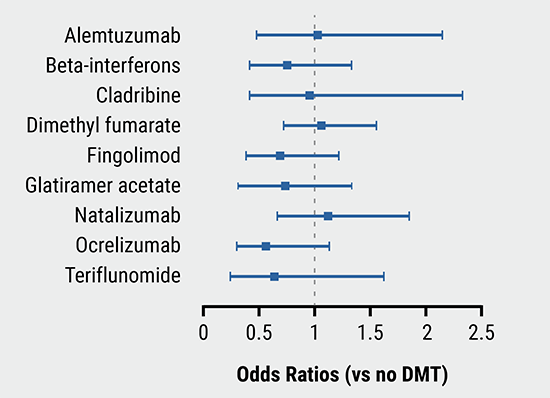https://doi.org/10.55788/b71ff3dc
The new EAN-ECTRIMS guideline “Update on the pharmacological treatment of people with multiple sclerosis” was presented at the EAN 2022 meeting [1]. Prof. Maria Pia Amato (University of Florence, Italy) summarised the main questions the guideline addresses.
The 5 core topics of the guideline include:
- Efficacy of DMDs.
- Early treatment decisions.
- Disease/treatment response monitoring and treatment modification.
- Treatment suspension and disease reactivation.
- Pregnancy and breastfeeding.
Added to these were 3 practical topics:
- Treatment safety and its monitoring.
- Disease-modifying therapy (DMT) switching strategies.
- Long-lasting effects of DMTs (alemtuzumab and cladribine).
The guideline supports not only early start of MS treatment but also early start of a higher-efficacy DMDs, depending on the degree of disease activity, either clinically or on MRI, and patient characteristics. This is an important difference from the previous edition of this guideline, Prof. Amato stressed. “It is an important message of this guideline that you should not lose time when treating a patient with an unfavourable prognosis, by giving them only moderately effective drugs.”
When treatment with a high-efficacy DMD is terminated for whatever reason, the guideline suggests starting another high-efficacy DMD, taking into account factors like clinical and MRI disease activity, pharmacokinetics, and the risk of resumed disease activity or even rebound (especially in natalizumab or S1P modulators). Prof. Amato added: “When a patient is stable and has no safety or tolerability issues, consider continuing treatment with a DMD, taking into account patient characteristics and comorbidities, drug safety profile, family planning, and patient values and preferences.”
Prof. Amato explained that a big part of the discussion was about recommendations regarding treatment of SPMS without evidence of inflammatory activity (relapses and/or MRI activity). “Particularly in young SPMS patients and those in whom progression has started recently, treatment with siponimod or anti-CD20 monoclonal antibodies should be considered, even though only scarce evidence is present to support their use in this setting, as well as the safety and tolerability profile of these drugs.”
When asked about radiologically isolated syndrome (RIS), Prof. Amato said treatment of RIS is not included in the guideline because evidence from clinical trials is lacking; there are however RIS trials ongoing with teriflunomide, dimethyl fumarate, and ocrelizumab.
- Amato MP. Getting Evidence into practice: The new EAN-ECTRIMS guideline “Update on the pharmacological treatment of people with multiple sclerosis”. SYMP02, EAN 2022, 25–28 April, Vienna, Austria.
Copyright ©2022 Medicom Medical Publishers
Posted on
Previous Article
« Gut microbiota composition associated with disability worsening Next Article
When to start, switch, and stop MS therapy: Real-world evidence counts »
« Gut microbiota composition associated with disability worsening Next Article
When to start, switch, and stop MS therapy: Real-world evidence counts »
Table of Contents: EAN 2022
Featured articles
Letter from the Editor
Overarching Theme
Migraine
Targeting cortical activation by transcranial magnetic stimulation
Erenumab more than doubles plasma CGRP levels
Over a third of patients responds late to CGRP antibodies
Multiple Sclerosis
When to start, switch, and stop MS therapy: Real-world evidence counts
Updated EAN-ECTRIMS guideline on pharmacological MS treatment
Gut microbiota composition associated with disability worsening
Teriflunomide in children with MS: final results of TERIKIDS
Estimating brain age in MS: machine learning versus deep learning
Ofatumumab improves cognitive processing speed
Parkinson’s Disease
Intestinal alterations in patients with Parkinson’s disease
Gene variants impact survival in monogenic Parkinson’s disease
Cerebrovascular Disease and Stroke
Most acute stroke patients have undiagnosed risk factors
Absence of Susceptibility Vessel Sign points to malignancy in stroke patients
Acute stroke management: from time window to tissue window?
Epilepsy
Seizure forecasting with non- and minimally-invasive devices
Real-world efficacy of cenobamate in focal-onset seizures
Possible new biomarker for early neuronal death in mesial temporal lobe epilepsy
COVID-19
COVID-19 elevates risk of neurodegenerative disorders
More headaches in adolescents during COVID-19 pandemic
AstraZeneca vaccination and risk of cerebral venous sinus thrombosis
Large impact of COVID-19 on dementia diagnosis and care
Miscellaneous
Tau autoimmunity associated with systemic disease
Long-term effects of avalglucosidase alfa in late-onset Pompe disease
European survey of patient satisfaction in the treatment of cancer-related neuropathic pain
Related Articles

November 25, 2020
Risk of COVID-19 not increased in MS patients
© 2024 Medicom Medical Publishers. All rights reserved. Terms and Conditions | Privacy Policy

